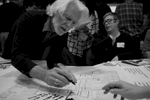Places: The Smallest Quadrant
The Smallest Quadrant
Despite being a longtime resident of Washington, D.C., until a few years ago, I had only stepped foot into the Southwest Quadrant a handful of times. Perhaps I overlooked it due to the highway that slices through the city’s underbelly, which cuts off the quadrant from its Northern half and squeezes it alongside the confluence of the Anacostia and Potomac Rivers. Or perhaps I stayed out because I first have to traverse the vast empty space on the Mall before arriving at a few dark underpasses beneath the SE-SW freeway, fixed portals from which pedestrians and vehicles emerge into Southwest’s otherworld- a sea of midcentury-style iconic buildings and town-home-ridged cul-de-sacs nestled along quiet, verdant streets.
Southwest D.C. interests me because of its prominence in the history of urban development, a case study in massive architectural changes and residential displacement that shifted its demographics in the 1940s and 50s. The area has been reimagined with the Wharf’s 2017 transformation. Southwest is unique in D.C. for its socio-economic mix of residents, where middle-income, low-income and wealthier residents live in close proximity to each other, frequenting the same public amenities, churches, parks and local businesses. Neighborhood changes taking place right now will impact everyone in some way and may either shift or reinforce the current community dynamic birthed from renewal efforts past.
As Southwest D.C. undergoes changes—a little over half a century after recovering from its first major overhaul—the images featured here capture key places on or near the waterfront in 2013-2015 so that we can look back on what the area looked like, where we are now, and what it might become.















